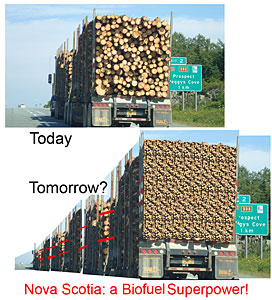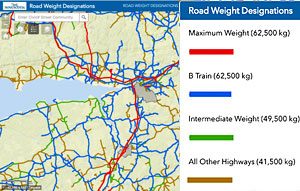 Atlantic Forestry Review (Sep 2017) provides a pretty unbiased perspective of forestry in Atlantic Canada, allowing different players or journalists writing about those players to express their perspectives and otherwise reporting on good news, bad news, human-interest news and just interesting news and facts about forests and forestry in our region.
Atlantic Forestry Review (Sep 2017) provides a pretty unbiased perspective of forestry in Atlantic Canada, allowing different players or journalists writing about those players to express their perspectives and otherwise reporting on good news, bad news, human-interest news and just interesting news and facts about forests and forestry in our region.
The various articles and reports in the current issue, the “2017 Trucking Issue”, illustrate some of the tensions between the big and smaller players.
In “Time to get rolling on road reform”, freelancer Dan Wooley writes about a report “released recently by FPInnovations on research conducted in concert with Forest Nova Scotia”. The report advocates lowering restrictions on Nova Scotia roads that limit the maximum GVW (Gross Vehicle Weight) to 62,500 kilograms, with “intermediate roads limited to 49,500 kg and all other roads to 41,500 kg. FPInnovations/Forest Nova Scotia complain about these restrictions because “truckers are often forced to choose between compliance and financial viability”.

Road Weight designations for NS can be viewed on an interactive map – click on image or go to TIR- Road Designation for more details
It’s all pretty much in the bag according to Chisholm who “by the end of this year expects regulatory changes to allow B-trains up to the road’s current maximum legal GVW…All in all, the Nova Scotia industry is very pleased with the progress we are making, working with TIR and DNR to bring us to a competitive position with other jurisdictions.”
Worried about bridges? Don’t: “Bridges shorter than 12 metres are generally fine if they are in good shape and meet certain safety standards and maintenance standards, explains Chisholm, and bridges shorter than eight metres do not present a problem at all. The longer the truck, the less truck there is on the bridges at any one time.” I guess the rest of us will make sure the bridges can take it.
Besides lower transport standards, biorefinery advocates would like to see “a 2% or even 5% mandate for biodiesel in Nova Scotia’s marine and heating fuel supply chain which would “be the de-risking of a significant portion of a commercial biorefinery’s output, while allowing the proponent to explore high-value export opportunities”, consolidation of softwood mills, and fulltree harvesting.
(View Post Feb 22, 2017)
In principle, we should be very careful about transporting logs for long distances because of the spread of pests such as the Hemlock Vampires, which are now in our province. Surely, it wouldn’t pay to use B-trains to transport logs 50 km, so it’s likely the FPInnovations/Forest Nova Scotia report hasn’t considered that angle. But I haven’t seen the report which seems not to be available in the public domain, so maybe it does. (I have requested a copy.)
Contrasting that story is the article by Gayle Wilson citing reminiscences and thoughts of Richard Countway, a Nova Scotia forester “who has seen the ups and downs in the forest industry”. Perhaps a one-truck but hardly a one-track guy, Conway is a wooden barrel cooper, an experienced trucker “for more than 50 of his 69 years”, a trained logger, educator and self-trained mechanic, also known as a “straight-shooter”, and also the article notes, a member of Forest Nova Scotia. He has adapted to those up and downs, but as the article describes, it is increasingly difficult unless you work for the big guys. A few quotes illustrate his perspectives
In 1987 when Countway took a 6-week, level 2 forestry course in Debert, and went into business as Richard Countway Silviculture Ltd:
We cut the rest and leave the best…today they cut the best and leave the rest.
After Hurricane Jan when he and his men spent “two and a half years down around east Musquodoboit and all those areas picking up the blowdown from Juan”:
The big guys were coming in, cutting, paying bigger prices, and I coudn’t compete…They just squeezed me right out.
“Standing back and looking at toady’s forest industry”, GW writes, “Countway criticizes the large-scale clearcutting that is going on:
A hundred acres today, there’s a poof and it’s gone, with the equipment there is.
GW writes “He believes that large companies such as WestFor, Great Northern Timber and Wagner wield too much control over wood prices, as well as trucking rates.
I mean, they had crews from Quebec and New Brunswick down here, just pounding ‘er. And the people are getting upset with it.
Despite the challenges and “no pension to speak of”, Countway maintains his commitment to smaller landowners and says, “I know I’ve got a good reputation. I don’t do people. It might start coming back a bit. You know, I’ve ridden some pretty hard storms.”
So getting big or remaining big in Nova Scotia is all about “bring[ing] us to a competitive position with other jurisdictions”, which means economies of scale (including fewer workers), more taxpayer dollars spent on infrastructure, and forgetting about forests as the forests that we and our wildlife have known.
There ARE other options which make use of skilled people such as Richard Countway, focus locally, and make use of new technologies on a small scale. We can “cut less and do more” as Robert Taylor, President of Taylor Lumber Co in Middle Musquodoboit says and has demonstrated can work in Nova Scotia.
There’s lots more of different perspectives in AFR Sept issue. Check it out to find one supporting your own, or read it all to help form one of your own, or just for interesting stuff about forests and forestry in Nova Scotia. The print-only Atlantic Forestry Review is published six times per year “for independent woodlot owners in the four provinces of Atlantic Canada”. The current subscription rate is $20/year for in-Canada subscribers, a bargain indeed.
